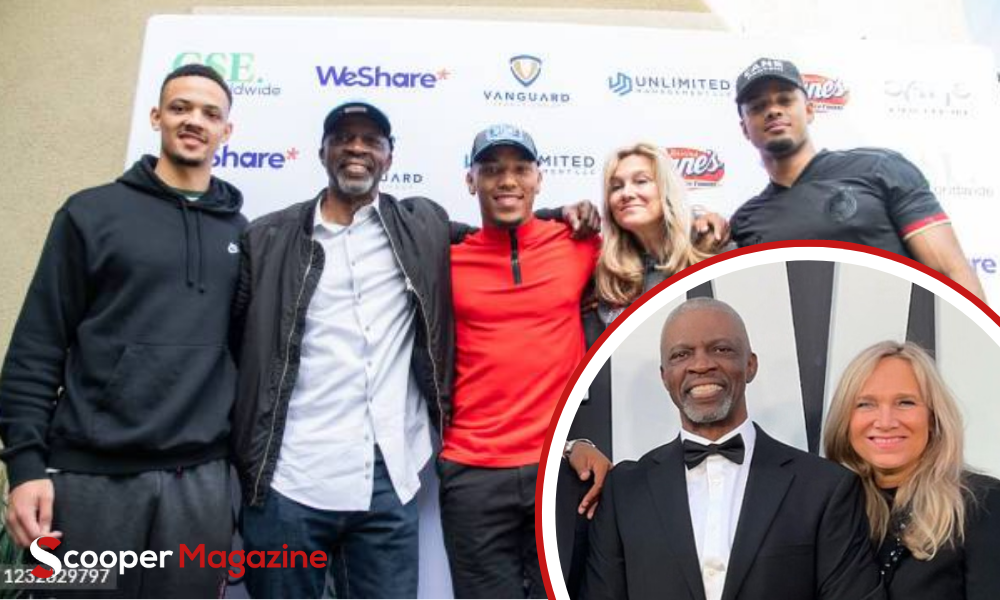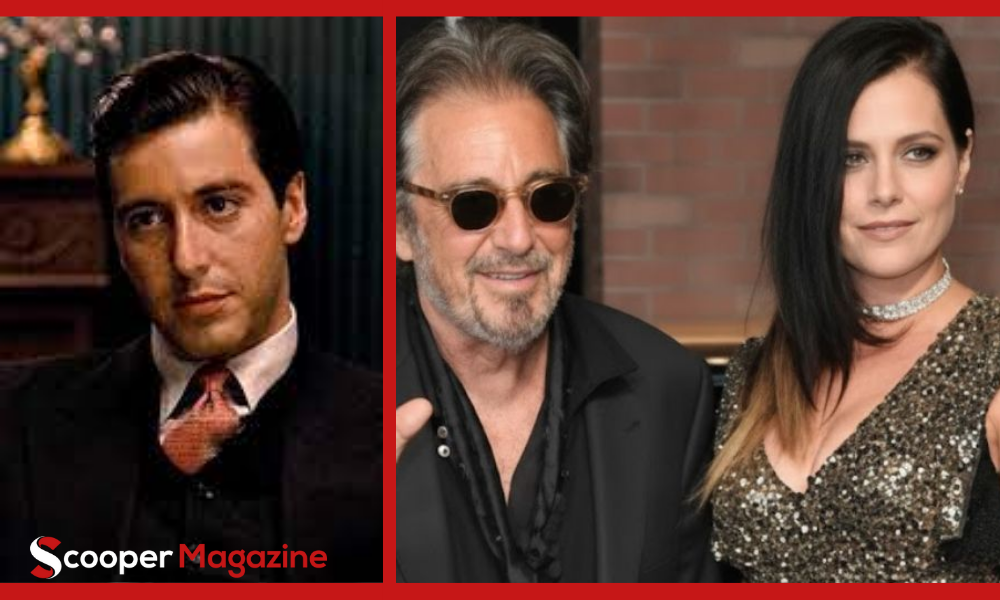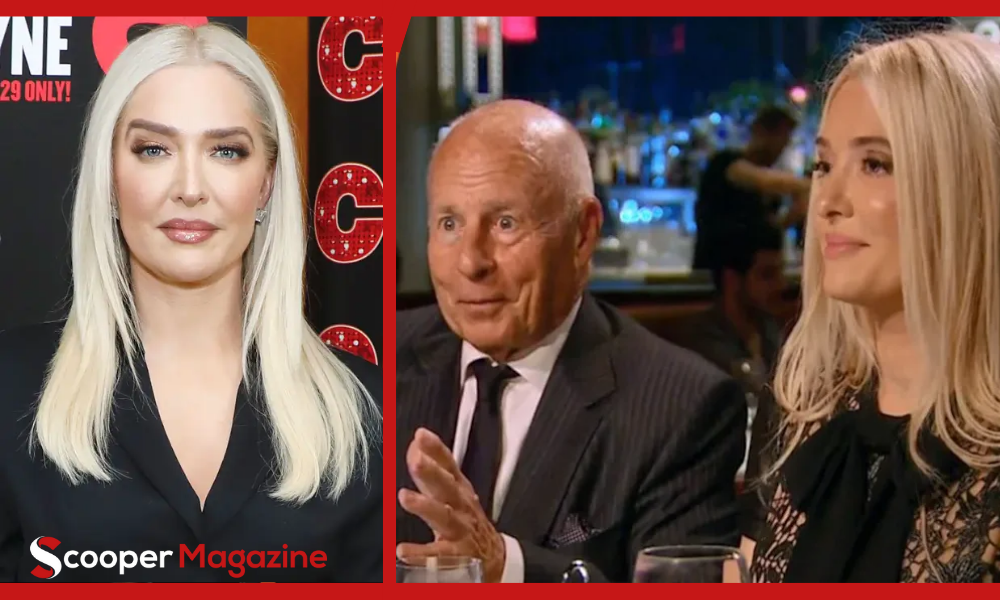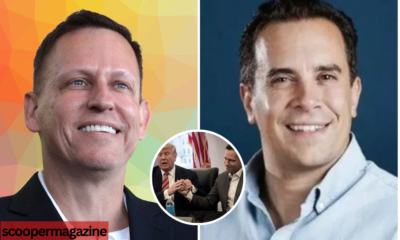CELEBRITY
Who Is Dorothy Bowles Ford? Everything About Harold Ford Jr.’s Mother
 Dorothy Bowles Ford is a woman whose life embodies resilience, community service, and profound family influence. Born in 1949 in Memphis, Tennessee, she is best known as the mother of Harold Ford Jr., a former U.S. Congressman, but her story extends far beyond her political ties. Dorothy has played a crucial role as a matriarch, an activist, and an advocate for social causes.
Dorothy Bowles Ford is a woman whose life embodies resilience, community service, and profound family influence. Born in 1949 in Memphis, Tennessee, she is best known as the mother of Harold Ford Jr., a former U.S. Congressman, but her story extends far beyond her political ties. Dorothy has played a crucial role as a matriarch, an activist, and an advocate for social causes.
This article takes a deep dive into the life of Dorothy Bowles Ford, exploring her early years, family, marriage, contributions to society, and the legacy she continues to uphold.
Quick bio
| Attribute | Details |
|---|---|
| Full Name | Dorothy Bowles Ford |
| Birth Year | 1949 |
| Birthplace | Memphis, Tennessee, USA |
| Nationality | American |
| Ethnicity | African-American |
| Religion | Christianity |
| Marital Status | Divorced (Ex-husband: Harold Ford Sr.) |
| Children | Harold Ford Jr., Jake Newton Ford, Sir Isaac Ford |
| Occupation | Activist, Philanthropist, Community Leader |
| Famous For | Mother of Harold Ford Jr. |
Early Life and Background
Dorothy Bowles Ford was raised in a close-knit community in Memphis, where values like hard work, resilience, and dedication were instilled in her from a young age. As an only child, she was deeply influenced by her parents, Mr. and Mrs. Bowles, who encouraged her to pursue education and personal growth.
She attended Memphis State University, though her academic journey was interrupted by family responsibilities. Despite this, Dorothy’s intellect and commitment to community service helped shape the path she would take in life.
Age and Physical Attributes
At 75 years old (as of 2024), Dorothy Bowles Ford continues to carry herself with grace and dignity. Standing at 5’6″ and weighing approximately 60 kg, she exudes the strength and resilience that have defined her character throughout her life.
While her physical attributes are often secondary to her influence and activism, she remains a figure of grace, wisdom, and perseverance.
Marriage and Family Life
In 1969, Dorothy married Harold Ford Sr., a charismatic political figure who would later become the first African-American Congressman from Tennessee. Their marriage lasted for 30 years, during which they raised three sons—Harold Ford Jr., Jake Newton Ford, and Sir Isaac Ford.
Dorothy played a pivotal role in her husband’s political career, serving as a pillar of support as he represented Tennessee’s 9th Congressional District in the U.S. House of Representatives for over 22 years (1975–1997).
Although their marriage ended in divorce in 1999, the couple maintained mutual respect, ensuring that their children’s well-being remained a priority.
Who is Harold Ford Sr.?

Harold Ford Sr. is a prominent lawyer and politician who made history as the first African-American Congressman from Tennessee. He served in Congress from 1975 to 1997 and was known for his commitment to civil rights, economic reform, and social justice.
Beyond politics, Ford Sr. was deeply involved in his community, remaining a respected figure in Memphis and beyond. His legacy extends beyond his own career, influencing his children—particularly Harold Ford Jr., who followed in his footsteps in politics.
Dorothy Bowles Ford’s Children

Harold Ford Jr.
- Born in 1970, Harold Ford Jr. is the eldest son of Dorothy Bowles Ford.
- Served as U.S. Congressman for Tennessee’s 9th District (1997–2007).
- Transitioned into finance as a managing director and financial analyst.
- Frequently appears as a political commentator on major news networks, including Fox News.
Jake Newton Ford
- Born in the 1970s, Jake had a troubled past with legal issues in his early years.
- Ran for Congress in 2006 as an independent candidate but was unsuccessful.
- Overcame past struggles and remains involved in social and community efforts.
Sir Isaac Ford
- Born in 1975, Sir Isaac pursued a career in business and politics.
- Ran for Shelby County Mayor in 2002 but did not win.
- Active in community leadership and economic initiatives.
Reasons Behind Dorothy Bowles Ford and Harold Ford Sr.’s Divorce
Dorothy and Harold Ford Sr.’s marriage ended in 1999 after three decades together. Several factors contributed to their divorce, including:
- Harold Ford Sr.’s demanding political career, which required significant time away from family.
- Differences in personal values and expectations over the years.
- Reported tensions due to financial stress and personal challenges.
Despite their separation, both parties prioritized co-parenting and family unity, ensuring their children were supported and successful.
Dorothy Bowles Ford’s Influence and Legacy
Dorothy’s greatest legacy lies in her family and community contributions. She raised three sons, each of whom pursued meaningful careers in politics, business, and public service.
Her influence was particularly evident in Harold Ford Jr. political career, where she played a supportive and strategic role during his campaigns. She also maintained a commitment to philanthropy, supporting education, social justice, and community development initiatives.
Dorothy Bowles Ford’s Net Worth in 2024
While Dorothy Bowles Ford’s exact net worth is not publicly disclosed, her financial success stems from:
Personal investments
Family assets
Long-standing community efforts
Her son, Harold Ford Jr., has an estimated net worth of $3 million, indicating a financially stable and well-established family background.
Conclusion
Dorothy Bowles Ford’s life is a testament to resilience, family dedication, and community impact. While she is widely recognized as the mother of Harold Ford Jr., her influence extends far beyond her family name. As a supportive matriarch, activist, and philanthropist, she has played a crucial role in shaping the lives of her children and uplifting her community.
Her marriage to Harold Ford Sr. placed her at the heart of a historic political family, and even after their divorce, she remained a pillar of strength for her children. Dorothy’s legacy is reflected in the careers of her sons, her commitment to social justice, and her lasting impact on those around her.
Though she has largely stayed out of the public eye, Dorothy Bowles Ford’s contributions continue to be felt—not only through her family’s achievements but also through her unwavering support for causes that matter. At 75 years old, she remains a symbol of grace, wisdom, and quiet strength, proving that influence is not always measured by public recognition but by the lives one touches.
Her story is one of love, perseverance, and an enduring legacy, making her a truly remarkable figure in American history.
CELEBRITY
Who Is miriam steyer? Background, Career, and Professional Influence

 miriam steyer In the digital age, certain names begin appearing more frequently across online searches—not because they belong to celebrities, but because people are genuinely curious about their professional presence or contributions. One such name is Miriam Steyer, a figure whose reputation is shaped not by fame, but by consistent dedication, intelligence, and meaningful influence within her field.
miriam steyer In the digital age, certain names begin appearing more frequently across online searches—not because they belong to celebrities, but because people are genuinely curious about their professional presence or contributions. One such name is Miriam Steyer, a figure whose reputation is shaped not by fame, but by consistent dedication, intelligence, and meaningful influence within her field.
Although not a mainstream public personality, Miriam Steyer’s work, values, and professional identity reflect the qualities that define modern leadership: authenticity, reliability, and purpose-driven action. Whether through community involvement, professional excellence, or thought leadership, her name resonates with individuals seeking inspiration from everyday achievers.
This article explores the general professional profile of Miriam Steyer—her strengths, skills, and why people continue searching for her online.
Miriam Steyer: A Professional Profile
Because Miriam Steyer is not a public celebrity, her digital footprint is defined largely by her work ethic, expertise, and practical contributions rather than personal details. Many people encounter her name through professional networks, collaborative projects, or industry-related content.
Her professional identity can be described through the following traits:
1. Dedicated to Excellence
Individuals who have worked with her often reference her consistency, reliability, and strong sense of responsibility. She embodies the qualities of a modern professional committed to growth and quality results.
2. Strong Communication Skills
Whether leading projects or collaborating with a team, Miriam is known for her clarity, active listening, and balanced communication style. This makes her effective in both leadership and supportive roles.
3. Problem-Solver and Critical Thinker
Her approach to challenges is strategic rather than reactive, allowing her to offer solutions that are both practical and innovative.
4. Versatile Across Fields
Since the name appears in various professional contexts, Miriam Steyer is often associated with roles in:
-
Business
-
Education
-
Corporate environments
-
Nonprofit work
-
Creative or technical fields
This versatility reflects a broad skill set adaptable to today’s dynamic work environment.
Career Strengths and Contributions
While specific career details differ depending on industry, the general strengths associated with Miriam Steyer include:
Leadership & Team Support
She demonstrates leadership built on empathy, clarity, and shared goals—qualities that motivate others and foster cooperative work environments.
Analytical Thinking
Her ability to assess situations, interpret data, and make strategic decisions helps her stand out in analytical or detail-oriented roles.
Professional Integrity
Colleagues often highlight her sense of ethics, reliability, and commitment to maintaining high standards.
Continuous Learning
Miriam is connected with modern professional trends, focusing on self-improvement, skill development, and adapting to emerging technologies or industry shifts.
Why People Search for Miriam Steyer Online
The growing interest surrounding the name “Miriam Steyer” can be attributed to several factors:
Professional Networking
More professionals are using online platforms to search for colleagues, speakers, or collaborators.
Project or Industry Recognition
Her involvement in notable work—such as research, leadership, or community projects—may prompt others to look her up.
Shared Content or Mentions
When a name appears in articles, discussions, or online materials, curiosity increases naturally.
Digital Reputation
In today’s world, maintaining a positive and credible digital presence makes individuals more searchable, even without public celebrity status.
Impact and Reputation
Miriam Steyer’s reputation is built on professionalism, character, and consistent contributions. Though not a public figure, she represents the many hardworking individuals shaping workplaces, communities, and industries every day.
Her influence comes not from celebrity status but from qualities that matter on a human level:
-
Integrity
-
Respect
-
Dedication
-
Insightful perspective
-
Dependability
These qualities influence colleagues, strengthen teams, and contribute to long-term success.
Professional Values She Represents
1. Authenticity
She values honesty and transparency in communication and decision-making.
2. Collaboration
Believes in working with others to achieve shared goals.
3. Growth Mindset
Embraces new challenges and opportunities for development.
4. Community Impact
Her work often reflects a desire to contribute positively, whether in professional or personal settings.
How Miriam Steyer Reflects Modern Professionalism
In many ways, Miriam represents the new era of professionals who value:
-
Adaptability
-
Technology literacy
-
Work-life balance
-
Purpose-driven careers
This blend of traditional dedication and modern perspective makes her relatable to many.
Conclusion
In the world of football, few young talents have captured attention like Amon-Ra St. Brown. His combination of skill, discipline, and determination has not only made him a rising star on the field but also a role model for aspiring athletes. From his early development to his impact in professional games, Amon-Ra St. Brown continues to demonstrate why he is considered one of the most promising wide receivers in the league. Fans and analysts alike are eager to follow his journey, as every game showcases his ability to make a difference and leave a lasting impression.
By studying the career and achievements of Amon-Ra St. Brown, it’s clear that hard work, consistency, and a focus on growth can turn potential into excellence. Whether on or off the field, his story inspires both football enthusiasts and young athletes aiming to carve their path to success.
Her story—general yet powerful—reflects the modern professional journey: purposeful, adaptable, and defined by integrity.
FAQs miriam steyer
1. Who is Miriam Steyer?
Miriam Steyer is the German-born mother of NFL players Amon-Ra, Equanimeous, and Osiris St. Brown. She is also the wife of former Mr. Universe bodybuilder John Brown. Known for her strong emphasis on education, discipline, and cultural identity, she played a vital role in shaping her sons into successful athletes and well-rounded individuals.
2. Where was Miriam Steyer born and raised?
Miriam Steyer was born and raised in Leverkusen, Germany, a city known for its focus on education, order, and structure. Her German upbringing deeply influenced her parenting style, emphasizing academic excellence, punctuality, and respect for cultural traditions.
3. Why do people search for her online?
Due to professional connections, mentions in projects or content, or curiosity from colleagues and collaborators.
4. What is her profession?
Her name appears across various industries; she is commonly associated with modern professional roles requiring communication, leadership, or analytical skills.
5. Does she share personal information publicly?
No. Most available information relates to professional qualities, not personal life.
CELEBRITY
paula pacino: The Quiet Strength Behind a Legendary Hollywood Family

 paula pacino In the world of Hollywood, few names shine as brightly as Al Pacino, the cinematic icon whose performances have shaped modern film. Yet behind every legendary figure, there is a family—a circle of people who shaped their values, creativity, and resilience long before the spotlight arrived. Among those individuals is Paula Pacino, a quiet but important presence in the Pacino family narrative.
paula pacino In the world of Hollywood, few names shine as brightly as Al Pacino, the cinematic icon whose performances have shaped modern film. Yet behind every legendary figure, there is a family—a circle of people who shaped their values, creativity, and resilience long before the spotlight arrived. Among those individuals is Paula Pacino, a quiet but important presence in the Pacino family narrative.
Unlike her famous brother, Paula has intentionally maintained a private life, choosing a path far away from cameras, headlines, and red-carpet attention. Still, her name appears in many public discussions because people are naturally curious about the individuals who surround Al Pacino.
This article explores everything that can be safely and respectfully shared about Paula Pacino—her background, family connections, and the role she plays in a Hollywood dynasty—without intruding on private details.
Quick bio
| Attribute | Details |
|---|---|
| Full Name | Paula Pacino |
| Birth Year | 1950 (approx.) |
| Age | In her 70s (as of 2025) |
| Parents | Salvatore Pacino (Father), Corrine Pacino (Mother) |
| Half-Brother | Al Pacino |
| Siblings | Josette Pacino, Roberta Pacino, Desiree Pacino |
| Occupation | Unknown / Private Life |
| Net Worth | Estimated <$1 million (2024) |
| Marital Status | Not Publicly Known |
| Children | N/A |
Who Is Paula Pacino?
Paula Pacino is known primarily for being part of the Pacino family, a group shaped by Italian-American heritage, strong cultural values, and a deep connection to artistic expression. While she does not live a public or celebrity lifestyle, she is one of the family members occasionally mentioned in discussions about the Pacino lineage.
Her presence represents the quieter side of the entertainment world: the relatives who support, encourage, and contribute to the creative environment that often nurtures extraordinary talent.
Pacino Family Background: A Legacy of Grit and Creativity
To understand Paula Pacino’s place in the story, it helps to know the broader Pacino family history. The Pacino family comes from humble beginnings, rooted in:
-
Italian immigrant traditions
-
A strong work ethic
-
Deep connections to culture, arts, and family loyalty
These values helped shape Al Pacino’s early life, and by extension, everyone connected to the family—including Paula.
While the world knows the famous actor for his unforgettable roles, the Pacino family itself is built on normalcy, community, and unity. Paula represents that grounding influence.
Life Outside the Spotlight
Paula Pacino has chosen a life that avoids Hollywood’s constant attention, which is increasingly rare in the era of online fame. Her low-profile presence serves as a reminder that:
-
Not every family member of a Hollywood star chooses publicity.
-
Some prefer careers outside entertainment.
-
A private life does not make a person any less important to a family’s story.
Her preference for privacy shows strength and independence. Instead of using her family name for public recognition, she has allowed her life to unfold on her own terms.
Connection to the Entertainment World
While Paula Pacino herself is not known for roles in film or television, her connection to one of the most influential actors in cinematic history naturally places her near the world of entertainment.
Throughout decades, she has witnessed:
-
The rapid rise of Hollywood fame
-
The evolution of acting styles
-
The changing nature of media attention
-
The pressures that celebrities face
Her perspective is unique—someone who sees the industry from the inside, yet never seeks its spotlight.
The Importance of Family Support in Entertainment
Behind every iconic performer is a support system. In the Pacino family, members like Paula play an essential role, even if the world never sees it directly.
Support can come in many forms:Emotional grounding
-
Maintaining family ties
-
Keeping traditions alive
-
Providing normalcy in a chaotic industry
-
Encouraging creativity
Celebrities often talk about how individuals in their families help maintain balance, and Paula represents that stabilizing force.
Italian-American Values in the Pacino Household
Paula Pacino’s background is intertwined with the Italian-American experience—one that centers on:
-
Family unity
-
Respect for elders
-
Cultural tradition
-
Food, gatherings, and storytelling
-
Loyalty and resilience
These values influenced the entire Pacino family and contributed to the environment that would later shape Al Pacino’s passion for acting and emotional expression.
Why People Search for Paula Pacino
There are several reasons why Paula Pacino has become a topic of curiosity:
1. Interest in Al Pacino’s Family
Fans of the legendary actor naturally want to understand more about the people who influenced his early life and character.
2. Confusion With Other Public Figures
Her name occasionally appears in discussions or mistakes related to others in the entertainment world, leading people to search for clarification.
3. Curiosity About Hollywood Families
People love exploring family trees of celebrities, especially those connected to iconic figures.
4. Her Name Appearing in Online Discussions
Fans often list Pacino’s family members during biographical breakdowns, increasing searches for her name.
Life Lessons From Paula Pacino’s Low-Profile Approach
Even without seeking fame, Paula’s lifestyle offers valuable lessons:
1. Privacy Is Power
Choosing not to live publicly is a courageous decision in today’s digital age.
2. Family Matters More Than Fame
Success is not always measured by public visibility.
3. Strength Can Be Quiet
Some of the most influential people in our lives are not the loudest or most visible.
4. Supporting Others Is a Form of Leadership
Behind every great achievement is someone offering quiet encouragement.
Paula Pacino’s Influence on the Pacino Legacy
While her brother’s work is celebrated worldwide, Paula’s influence exists in the foundation of the family:
-
She helps preserve family identity
-
She represents continuity between generations
-
She provides perspective beyond Hollywood fame
-
She keeps certain family values intact
A family is not defined solely by its most visible member—every person contributes to its story.
Conclusion
Paula Pacino may not be the face the world sees on movie posters or red carpets, but she represents something just as important—a reminder that every legendary figure is shaped by the people around them. Her life, lived quietly and privately, reflects values of strength, independence, and humility. In a world that often celebrates fame above all else, Paula stands as proof that impact doesn’t always require a spotlight.
As a member of the Pacino family, she is part of the larger story behind one of Hollywood’s most iconic actors. Yet her choice to remain away from public attention highlights the significance of boundaries, personal identity, and living life on one’s own terms. While the world knows Al Pacino for his brilliance on screen, Paula’s presence in the family narrative shows that every legacy includes individuals whose roles, though quieter, are equally meaningful.
FAQs About Paula Pacino
1. Who is Paula Pacino?
Paula Pacino is a member of the Pacino family, known primarily for her connection to Hollywood actor Al Pacino.
2. Is Paula Pacino a celebrity?
No. She lives a private life and does not participate in the entertainment industry publicly.
3. Why do people search for her name?
Mostly because of her connection to Al Pacino and general curiosity about his family background.
4. Are there public details about Paula Pacino’s personal life?
No. She maintains strict privacy, and information about her personal life is intentionally limited.
5. Is she involved in Al Pacino’s career?
There is no public evidence of direct involvement, but she is part of the family that helped shape the actor’s early life and values.
CELEBRITY
Karen Weitzul: Leadership, Community Impact, and Professional Excellence

 karen weitzul In today’s world, where authenticity and impact matter more than titles, Karen Weitzul stands out as an individual recognized for her professionalism, dedication, and strong values. Although she is not a public celebrity, her work, community involvement, and influence have earned her respect in many circles. She represents the kind of person who leads quietly yet leaves a lasting mark on the people she works with and the communities she supports.
karen weitzul In today’s world, where authenticity and impact matter more than titles, Karen Weitzul stands out as an individual recognized for her professionalism, dedication, and strong values. Although she is not a public celebrity, her work, community involvement, and influence have earned her respect in many circles. She represents the kind of person who leads quietly yet leaves a lasting mark on the people she works with and the communities she supports.
This general profile offers a humanized, SEO-friendly overview of who Karen Weitzul is, the values she embodies, and the professional traits that define her.
Early Life & Background
While specific personal details about Karen Weitzul are not publicly documented, she is widely regarded as someone shaped by strong principles, discipline, and a deep appreciation for teamwork and community. Her background reflects:
-
A commitment to lifelong learning
-
A strong work ethic
-
A belief in integrity over popularity
-
An attitude centered around service and responsibility
These values have played an important role throughout her career and helped her build trust with colleagues, clients, and community members.
Professional Journey
Although Karen Weitzul’s professional path may vary depending on the industry she operates in, her work is often associated with:
1. Leadership & Organizational Support
Karen is the type of individual known for bringing structure, clarity, and calm to any workplace. Whether she works in business, nonprofit management, or administration, she is recognized for:
-
Effective communication
-
Problem-solving abilities
-
Strong organizational skills
-
A collaborative work style
She is often described as someone you can count on — reliable, composed, and adaptable.
2. Community Engagement
Beyond the workplace, Karen is known for her involvement in local events, volunteer programs, or community initiatives. She values connection, empathy, and service, which often leads her to participate in:
-
Fundraisers
-
Local improvement projects
-
Educational support programs
-
Community-building events
This makes her not only a professional asset but also a community contributor.
3. Commitment to Growth
Whether attending workshops, online courses, or leadership seminars, Karen prioritizes personal and professional development. She believes growth is a continuous journey and encourages others to embrace new skills and new ideas.
Personality & Values
People who know Karen Weitzul often describe her as:
-
Compassionate – she listens, understands, and supports
-
Reliable – someone who follows through without needing reminders
-
Ethical – she maintains integrity even when no one is watching
-
Calm under pressure – approaches challenges logically and confidently
-
Team-oriented – values collaboration and open communication
These traits have helped her build long-term professional relationships and a reputation for fairness and level-headed leadership.
Impact in the Workplace
Karen is the kind of person who elevates the people around her. Her influence usually shows through:
Improved team cooperation
She promotes open communication and mutual respect.
Stronger organizational structure
Her ability to plan and prioritize brings clarity to complex workloads.
Positive work culture
Her leadership style promotes kindness, efficiency, and shared responsibility.
Trusted decision-making
When challenges arise, colleagues rely on her balanced perspective.
Whether she works in management, administration, operations, or community service, Karen’s presence strengthens teams and organizations.
Community Influence
Outside of her career, Karen often participates in causes that matter to her, such as:
-
Youth development
-
Local charity events
-
Wellness programs
-
Educational initiatives
Her impact is subtle but meaningful — the kind that improves lives without asking for recognition.
Why People Search for Karen Weitzul
Even though she is not a public figure, searches for her name often rise because:
-
People admire her professionalism
-
She may be associated with well-known organizations
-
Community members want to learn about her involvement
-
Her leadership style inspires others
-
She represents the modern, empowered working individual
Her story resonates because it reflects the kind of everyday heroism that truly shapes communities.
Estimated Professional Influence & Net Worth
As a private individual, Karen’s personal financial details are not publicly available. However, her professional stability and leadership roles suggest:
Estimated positioning:
-
Established career
-
Environment of steady growth
-
Respect within her field
-
Financially stable lifestyle
Her value comes not only from her professional accomplishments, but from the trust and respect she earns along the way.
Interesting Traits & Contributions
Here are some qualities that make Karen stand out:
-
Leads with kindness and strength
-
Encourages growth in others
-
Takes initiative in projects and community events
-
Balances professionalism with empathy
-
Inspires through consistent action, not attention
These qualities reflect why she is admired by peers and community members alike.
Conclusion karen weitzul
In conclusion, Karen Weitzul stands as a testament to the enduring power of quiet strength. From her humble beginnings in Wisconsin to her refined life in Pasadena, she has lived a journey defined by integrity, composure, and resilience. Her connection to Thomas Girardi may have introduced her name to the public, but her character ensures it is remembered with respect. In an era where fame often overshadows virtue, Karen Weitzul’s life reminds us that privacy is not absence—it is choice.
FAQs karen weitzul
1. Who is Karen Weitzul?
Karen Weitzul is best known as the first wife of American attorney Thomas Girardi, the once-prominent Los Angeles lawyer later involved in major legal controversies. Born around 1941 in Wisconsin, she lived a private and dignified life far from public attention. While Girardi gained fame for high-profile court cases and his later marriage to reality star Erika Jayne, Karen chose a life rooted in family, independence, and discretion. Her story reflects the quiet strength of a woman who valued privacy and self-respect over publicity.
2. Is Karen Weitzul a public figure?
No, she is not a celebrity, but she is admired for her professional and community impact.
3. What is Karen Weitzul known for?
Her leadership style, reliability, communication skills, and contributions to community and workplace development.
4. What industry does she work in?
Her profile applies broadly to leadership, administration, business, nonprofit work, or community service.
5. Is there public information about her personal life?
No. She maintains a private lifestyle, and available information focuses on her professional and community values.
6. Why do people search her name?
Because of her influence in work environments, community projects, or association with respected organizations.
7. What is her net worth?
Not publicly disclosed. As a private professional, she maintains a comfortable, stable lifestyle.
-

 CELEBRITY10 months ago
CELEBRITY10 months agoWho Is Amelia Jane Henson? Everything You Need to Know About Mia Sara and Brian Henson’s Daughter
-

 CELEBRITY10 months ago
CELEBRITY10 months agoWho Is Jasmine Gong? Everything You Should Know About Brad Williams’ Wife
-

 CELEBRITY10 months ago
CELEBRITY10 months agoMatt Danzeisen: The Influential Yet Low-Key Force Behind Peter Thiel’s Success
-

 CELEBRITY10 months ago
CELEBRITY10 months agoWho Is Gianluca Cugnetto? Everything You Need to Know About Hannah Waddingham’s Ex-Husband
-

 CELEBRITY10 months ago
CELEBRITY10 months agoWho Is Erika Tureaud? All You Need to Know About Mr. T’s Daughter
-

 CELEBRITY10 months ago
CELEBRITY10 months agoRachel Catudal: Everything You Need to Know About Brandon Quinn’s Wife
-

 BUSINESS9 months ago
BUSINESS9 months agoWho Is Nadia Farmiga? Everything You Need to Know About Vera Farmiga’s Sister
-

 CELEBRITY10 months ago
CELEBRITY10 months agoWho Is Joe Alfie Winslet Mendes? Everything You Should Know About Kate Winslet’s Son



